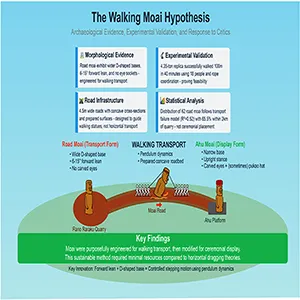
Hundreds of giant stone statues on Easter Island actually "walked" into place
Across the vast Pacific lies Rapa Nui, or Easter Island, home to the majestic moai statues that have long stirred human curiosity.
For centuries, the question persisted: How did ancient islanders move these colossal figures across rugged terrain without modern tools?
Now, a blend of physics, 3D modeling, and hands-on experimentation provides the most convincing answer yet.
A team led by Binghamton University’s Carl Lipo and the University of Arizona’s Terry Hunt has revealed that the statues didn’t just move – they walked.
Physics meets the past
Lipo and Hunt studied nearly 1,000 moai statues. Their findings suggest the people of Rapa Nui used ropes to rock the statues in a zigzag motion, guiding them upright along specially designed roads.
This explanation overturns older theories that proposed the statues were dragged horizontally on wooden sleds.
“Once you get it moving, it isn’t hard at all – people are pulling with one arm. It conserves energy, and it moves really quickly,” said Lipo.
“The hard part is getting it rocking in the first place. The question is, if it’s really large, what would it take? Are the things that we saw experimentally consistent with what we would expect from a physics perspective?”
Testing the walking theory
To test their hypothesis, Lipo’s team created high-resolution 3D models of the statues.
They identified distinct features – wide D-shaped bases and a forward lean – that would help the moai rock forward efficiently.
The researchers then constructed a 4.35-ton replica statue with these traits. With only 18 participants, they managed to “walk” the statue 328 feet (100 meters) in 40 minutes.
This success marked a major breakthrough compared to earlier trials.
“The physics makes sense. What we saw experimentally actually works. And as it gets bigger, it still works,” Lipo enthused.
“All the attributes that we see about moving gigantic ones only get more and more consistent the bigger and bigger they get, because it becomes the only way you could move it.”
Roads built for Easter Island statues
The ancient Rapa Nui roads, about 15 feet (4.5 meters) wide with a concave cross-section, supported the walking statues perfectly. These paths weren’t mere travel routes – they were part of the moving process itself.
“Every time they’re moving a statue, it looks like they’re making a road. The road is part of moving the statue,” said Lipo.
“We actually see them overlapping each other, and many parallel versions of them. What they are probably doing is clearing a path, moving it, clearing another, clearing it further, and moving it in certain sequences. So they’re spending a lot of time on the road part.”
When stone giants walk
According to Lipo, this walking theory stands unchallenged. No alternative explanation fits the available evidence as completely.
“Find some evidence that shows it couldn’t be walking, because nothing we’ve seen anywhere disproves that,” said Lipo. “In fact, everything we ever see and ever thought of keeps strengthening the argument.”
Lipo noted that Rapa Nui has long attracted imaginative but untested ideas. His team’s experiment-driven approach, grounded in physics and direct observation, raises the bar for evidence-based archaeology.
Beyond solving a mystery, it highlights the ingenuity of the island’s original inhabitants.
“It shows that the Rapa Nui people were incredibly smart. They figured this out,” Lipo noted. “They’re doing it the way that’s consistent with the resources they have.”

Culture behind Easter Island statues
The moai were more than just works of art. They symbolized ancestors who provided protection and guidance. Each statue represented a revered leader or clan member, linking the living to their heritage.
Moving them upright carried both spiritual and social meaning. The act of making these figures “walk” may have reflected the journey of the ancestors watching over their descendants.
Lipo’s findings bring a human touch to a story often overshadowed by mystery. The idea that the statues walked connects engineering brilliance with cultural depth.
It shows how practical needs intertwined with belief, creating an elegant harmony between science and spirituality.
Lessons from the ancients
The Rapa Nui story holds lessons for the modern world. It reveals how innovation thrives under limitation.
The islanders faced scarce resources, isolation, and challenging geography, yet they achieved something extraordinary. Their success reminds us that creativity often emerges through necessity.
Lipo’s research also highlights the power of evidence and persistence in uncovering truth. Centuries of speculation gave way to clarity through teamwork, experimentation, and physics. The moai’s walk now stands as a symbol of human ingenuity – past and present alike.
This discovery breathes new life into an age-old puzzle. By combining creativity with scientific rigor, modern researchers have retraced the footsteps of a civilization that once made stone giants walk.
The statues’ steady steps echo through time, reminding us that curiosity, reason, and respect for the past can still move mountains – or make them walk.
Click here to watch a video of the Moai statues walking…
The study is published in the Journal of Archaeological Science.
—–
Like what you read? Subscribe to our newsletter for engaging articles, exclusive content, and the latest updates.
Check us out on EarthSnap, a free app brought to you by Eric Ralls and Earth.com.
—–













